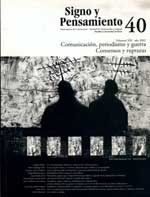Abstract
En el siguiente análisis se quiere mostrar cómo las imágenes y los discursos de las cadenas de televisión estadounidense enmarcaron los ataques terroristas del 11 de Septiembre de manera tal que provocaron una histeria de guerra pero no lograron dar una explicación coherente de lo que pasó, por qué sucedió, y cuál podría considerarse una respuesta responsable. Mediante un análisis de los discursos, las escenas y las imágenes predominantes transmitidas por los medios sobre los cuales se basó el debate público en los días posteriores a los ataques terroristas del 11 de septiembre, se propone mostrar cómo los principales medios de comunicación de los Estados Unidos privilegiaron el modelo del "conflicto entre civilizaciones", establecieron un dualismo binario entre el terrorismo islámico y la civilización, y difundieron ampliamente una fiebre de guerra, un sentimiento y un discurso que exigía toma de represalias y apoyaban alguna forma de intervención militar. El argumento de este escrito es que ese militarismo unidimensional podría empeorar la crisis actual en lugar de ofrecer soluciones al problema del terrorismo mundial. En consecuencia, y a pesar de que en una democracia los medios deberían promover el debate crítico de los temas urgentes para la nación, en esta crisis del terror los principales medios de comunicación estadounidenses, en particular la televisión, promovieron una fiebre de guerra y una solución militar al problema del terrorismo mundial.This journal is registered under a Creative Commons Attribution 4.0 International Public License. Thus, this work may be reproduced, distributed, and publicly shared in digital format, as long as the names of the authors and Pontificia Universidad Javeriana are acknowledged. Others are allowed to quote, adapt, transform, auto-archive, republish, and create based on this material, for any purpose (even commercial ones), provided the authorship is duly acknowledged, a link to the original work is provided, and it is specified if changes have been made. Pontificia Universidad Javeriana does not hold the rights of published works and the authors are solely responsible for the contents of their works; they keep the moral, intellectual, privacy, and publicity rights.
Approving the intervention of the work (review, copy-editing, translation, layout) and the following outreach, are granted through an use license and not through an assignment of rights. This means the journal and Pontificia Universidad Javeriana cannot be held responsible for any ethical malpractice by the authors. As a consequence of the protection granted by the use license, the journal is not required to publish recantations or modify information already published, unless the errata stems from the editorial management process. Publishing contents in this journal does not generate royalties for contributors.


